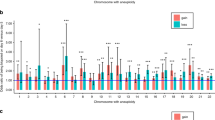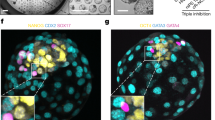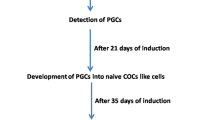Abstract
TECHNIQUES have been perfected for the culture in vitro of late two cell mouse ova into blastocysts in simple chemically defined conditions1,2. Attempts to obtain development from earlier stages have failed, unless the ova were cultured in organ cultures of the fallopian tube3,4. These results suggested that the fallopian tube provides some critical contribution necessary for the development of the mouse zygote into the late two cell stage. Nevertheless, it has been a common experience that when the mouse zygote is cultivated independently of the fallopian tube a few cleave to the two cell stage and then cease development5. It has now been shown6, however, that a high percentage of zygotes cleave to two cell stages and then cease development when cultured in Waymouth7 medium supplemented with ATP, deoxynucleosides and a feeder layer of irradiated HeLa cells. These experiments suggest that the initial development of the mouse zygote is dependent on a supply of exogenous factors, additional to those required by later stages.
This is a preview of subscription content, access via your institution
Access options
Subscribe to this journal
Receive 51 print issues and online access
$199.00 per year
only $3.90 per issue
Buy this article
- Purchase on Springer Link
- Instant access to full article PDF
Prices may be subject to local taxes which are calculated during checkout
Similar content being viewed by others
References
Brinster, R. L., Exp. Cell Res., 32, 205 (1963).
Brinster, R. L., J. Reprod. Fertil., 10, 227 (1965).
Biggers, J. D., Gwatkin, R. B. L., and Brinster, R. L., Nature, 194, 747 (1962).
Brinster, R. L., and Biggers, J. D., J. Reprod. Fertil., 10, 277 (1965).
Discussion in Preimplantational Stages of Pregnancy, Ciba Foundation Symposium (edit. by Wolstenholme, G. E. W., and O'Connor, M.), 414 (Churchill Ltd. London, 1965).
Cole, R. J., and Paul, J., inPreimplantational Stages of Pregnancy, Ciba Foundation Symposium (edit. by Wolstenholme, G. E. W. and O'Connor, M.), 86 (Churchill, Ltd. London, 1965).
Waymouth, C., J. Nat. Cancer Inst., 22, 1003 (1959).
Parker, R. C., Methods of Tissue Culture, third ed. (Harper and Bros., New York, 1961).
Ham, R. G., Exp. Cell Res., 29, 515 (1963).
Chen, J. M., Exp. Cell Res., 7, 518 (1954).
Biggers, J. D., Moore, B. D., and Whittingham, D. G., Nature, 206, 734 (1965).
Ohno, S. in Congenital Malformations, 36 (The International Medical Congress, Ltd., New York, 1964).
Brinster, R. L., J. Exp. Zool., 158, 69 (1965).
Author information
Authors and Affiliations
Rights and permissions
About this article
Cite this article
WHITTINGHAM, D., BIGGERS, J. Fallopian Tube and Early Cleavage in the Mouse. Nature 213, 942–943 (1967). https://doi.org/10.1038/213942a0
Published:
Issue Date:
DOI: https://doi.org/10.1038/213942a0
This article is cited by
-
Connections between preimplantation embryo physiology and culture
Journal of Assisted Reproduction and Genetics (2013)
-
Enhancement of the developmental potential of mouse oocytes matured in vitro by gonadotropins and ethylenediaminetetraacetic acid (EDTA)
Journal of In Vitro Fertilization and Embryo Transfer (1989)
-
Culture of rabbit embryos and isolated blastomeres in hydrogel chambers implanted in the peritoneal cavity of intermediate mouse recipients
Journal of In Vitro Fertilization and Embryo Transfer (1988)
-
Cytoplasmic control of preimplantation development in vitro in the mouse
Nature (1982)
Comments
By submitting a comment you agree to abide by our Terms and Community Guidelines. If you find something abusive or that does not comply with our terms or guidelines please flag it as inappropriate.



